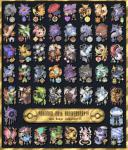Kemono-Kay said:
I) Sure, not all savannas will have those kinds of trees, but the umbrella thorn acacia is characteristic of the African savanna.II) True enough, but what happens if the distance is too great to tell if it's grass or blurry bushes/trees?
III) True, but this doesn't necessarily imply that images without it are deserts. The view of the grass may be blocked, or the view may exclude the ground.
IV) Fair enough.
V) Fair enough. I don't see it, but that's not really the point either way.
VI) The marks are paw prints. The lines are ambiguously either ground or grass, but it's stylised too much to really tell. The trees seem to have a good amount of foliage, though, making it less likely that it's a desert.
I) There are acacia forests and acacia trees from deserts (see VI).
II) Then the tag shouldn't be used, grassy terrain (no pokémon reference intended) is one of the most prominent characteristics of a savanna, without grass can't be said it is a savanna.
III) If no grass can be seen then don't tag it with 'savanna' because may not be one, it may be a desert or even a garden (believe me, people plant the strangest things in gardens); we tag only what is shown in the image.
VI) Here an example of a desert tree (note it is an acacia).
Kemono-Kay said:
The thing is, while a savanna is a kind of grassland, it's possible to identify it without any grass being unambiguously visible. That's what I had hoped to show by listing off those images.
Sorry but actually not. A savanna without grass would be like a forest without trees, a glacier without ice or a salar without salt. You can't say it truly is a savanna if grass isn't visible.
Updated by anonymous
